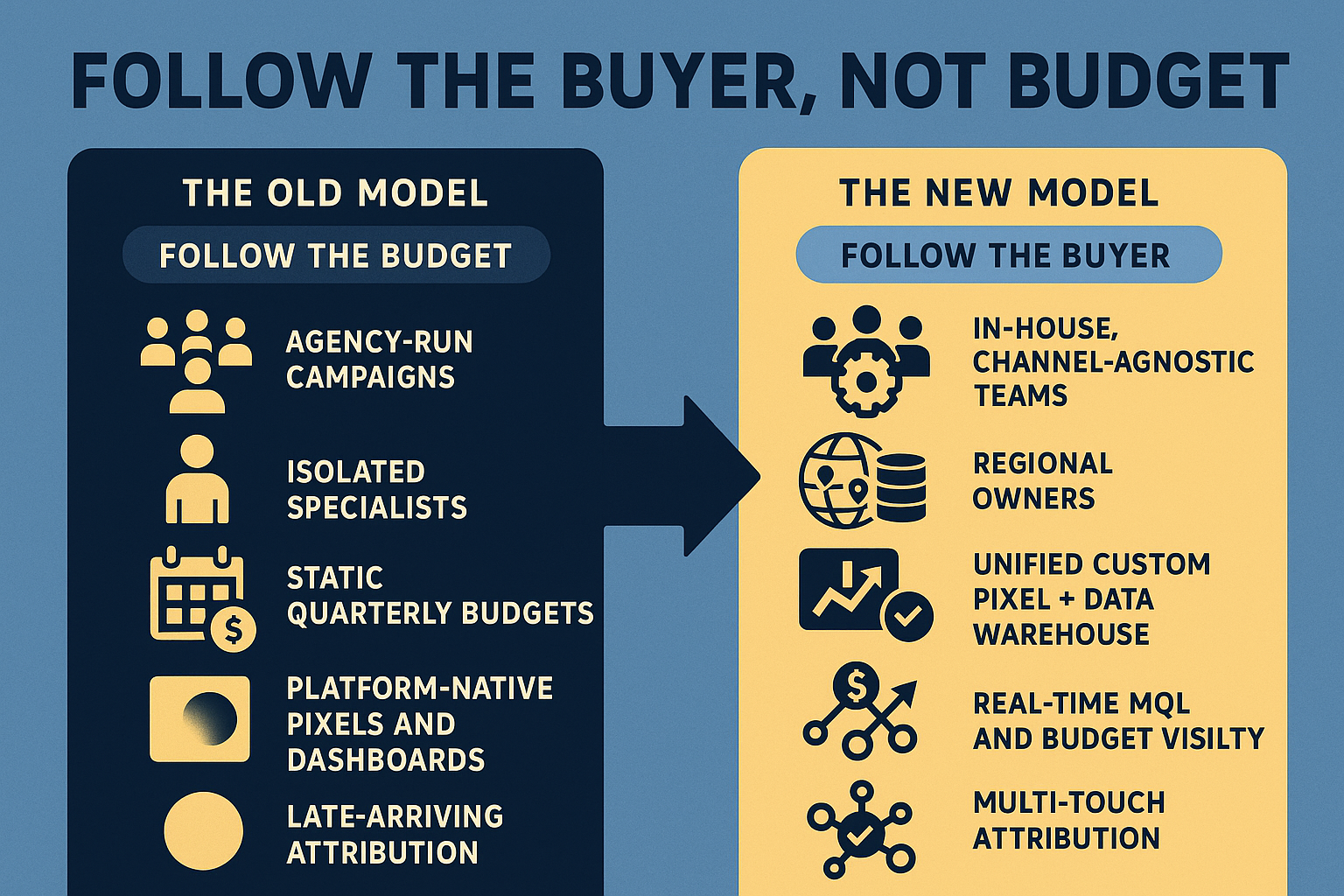Last week we spoke with the global paid media lead at an $80 billion cloud storage company.
On paper, their story looks like every other enterprise marketing transformation slide you’ve ever seen: move in-house, unify data, build attribution, get smarter. But listening to how they actually did it, what stood out wasn’t the stack. It was the sequence.
They didn’t “modernize marketing.” They changed what they were organizing around.
Three years ago, their paid engine was built to follow the budget.
Today, it’s built to follow the buyer.
That sounds like the kind of slogan you’d find on a keynote slide, but it’s not a slogan. It’s an operating system change.
And it has consequences.
The Old Operating System: Follow the Budget
If you work in B2B, this story will sound painfully familiar.
A few years ago, their media program looked like this:
- Big agency relationship running most campaigns
- Channel specialists scattered across teams (the Facebook person, the LinkedIn person, the Google person)
- Fixed quarterly budgets allocated per channel
- Native platform pixels and dashboards as the primary source of “truth”
- Bulk exports into spreadsheets for “analysis”
- Attribution that was, at best, suggestive and, at worst, fiction
- Optimizations happening days or weeks after the campaigns had ended
This is how most enterprise marketing teams still run. It’s not broken in the catastrophic sense. Budgets get spent, reports get shipped, leads show up.
But it’s built on a premise that made sense in an earlier era:
Channels are the primary unit of control.
You slice the world into platforms: LinkedIn, Google, Facebook, programmatic, whatever. You assign owners. You assign budgets. You hope that somehow the customer journey will respect those swimlanes.
Of course, it doesn’t.
Buyers don’t experience your go-to-market like an org chart. They experience it like a story. They see an ad on LinkedIn, Google your brand, click a competitor’s comparison page, talk to a colleague on Slack, come back through a retargeting ad, and eventually fill out a form six weeks later.
The budget, meanwhile, is sitting neatly in its silos, pretending this is all separate.
The New Operating System: Follow the Buyer
So what did this team actually change?
They didn’t just swap tools. They changed what everything was organized around.
The new model looks roughly like this:
- In-house, channel-agnostic teams, not agency silos
- Regional leaders (Americas, EMEA, APJ) who own outcomes, not channels
- All platforms as interchangeable tools, not fiefdoms
- A custom unified pixel feeding into their own data warehouse
- Real-time cost-per-MQL tracking, not just CPCs and CTRs
- Real-time visibility into budget shifts by performance and seasonality
- Multi-touch attribution that connects ad exposure to closed-won deals
The key shift is deceptively simple:
Stop organizing around where the money goes.
Start organizing around how the buyer moves.
Once that becomes the governing principle, a few things follow.
Channels Become Inputs, Not Identities
In the old system, you had a “LinkedIn person” whose job was to defend the LinkedIn budget.
In the new system, LinkedIn is just one of many levers. Its purpose is not to “get spend.” Its purpose is to move buyers from one stage of the journey to the next at an acceptable cost.
And here’s what they’re seeing in the data:
- LinkedIn costs more per click, often significantly.
- But lead quality is higher, sometimes dramatically.
- When they measure cost per MQL instead of cost per click, LinkedIn becomes comparable to cheaper channels.
- In some regions, LinkedIn is the workhorse. In others, search or programmatic takes the lead.
The point isn’t that LinkedIn is magically better. The point is that the metric changed.
Once you follow the buyer, cost per MQL and cost per opportunity matter more than cost per click. And once that’s true, budgets stop being promises and start being hypotheses.
If a channel underperforms, the money moves. Not next quarter. Now.
What They’ve Actually Solved
It’s tempting to hear this and assume the story ends with a fully automated, AI-driven media machine that never needs human hands on the wheel.
That’s not what’s happening.
What this team has done is more modest, and more instructive: they’ve solved some problems, and fully admitted they haven’t solved others.
Here’s what they consider “done” (for now):
- Reporting: Solved.
They have a single, unified view of performance across channels, mapped to stages in the funnel. No more reconciling three dashboards and a spreadsheet. - Attribution: Solved enough to act.
Is it perfect? No. Is any attribution model? Also no. But it’s good enough to show that certain patterns of exposure, over time, reliably correlate with pipeline and revenue. And that’s enough to move money.
Here’s what’s still painfully manual:
- Shifting budgets between platforms and ad groups.
Someone still has to log into Google Ads, into LinkedIn, into whatever else they’re running, and change the numbers. - Campaign setup and creative activation.
Someone has to build the ads, traffic the creative, manage the UTM discipline, keep naming conventions clean. - Activation workflow.
There’s no magical “run the perfect cross-channel campaign for APJ” button. There are smart people, good systems, and a lot of clicking.
So the current state looks like this:
- Reporting: ✅
- Attribution: ✅
- Dynamic optimization: ⏳
- Activation workflow: ⏳
They’re not chasing some imaginary state of total automation. They’re sequencing the work.
The Power of Solving One Layer at a Time
What impressed me most about this team wasn’t their tech stack. It was their patience.
They didn’t try to leap from siloed spreadsheets to real-time, fully automated, multi-touch, AI-optimized nirvana.
They did something more practical:
- Take back control
They moved from agency-run to in-house, channel-agnostic teams. That gave them ownership of the levers. - Unify the data
They built a custom pixel and pushed everything into their own warehouse. That gave them visibility. - Build attribution on top of that
Once the data was unified, they could experiment with models that reflected their actual buyer journey. That gave them insight. - Only then did they tackle activation and optimization
Now, with control, visibility, and insight, they’re working on making activation more efficient and real-time optimization more automated.
Control → Visibility → Insight → Efficiency → Speed.
Most teams try to reverse that order. They want speed and automation first. They want the AI that will tell them where to spend, before they own the spend, before they trust the data, before they understand the journey.
That’s why so many “marketing transformations” collapse into dashboards: beautiful interfaces layered on top of bad assumptions.
What This Means for B2B Marketers
If you’re spending $50K+ per month on B2B ads, the temptation is to think your problems are unique. Your product is complex. Your buyer is skeptical. Your market is weird.
The truth is, most teams at that level are stuck on the same staircase, in roughly the same place.
- They’re over-indexed on what platforms can report, under-indexed on what their buyers actually do.
- They’ve outsourced too much of the thinking to agencies and too much of the data to walled gardens.
- They’re trying to jump from first-generation reporting to fourth-generation automation in one move.
The story from this cloud storage company suggests a different posture:
You don’t need to become “modern” in one leap.
You need to change what you’re optimizing for, then move one layer at a time.
So if you’re in that $50K+ range and wondering what to do next, here’s a rough roadmap inspired by their journey:
- Reorganize around the buyer, not the channel.
- Kill the identity of “the LinkedIn person” and “the Google person.”
- Replace it with regional or segment owners who are accountable for pipeline, not impressions.
- Bring critical media operations in-house.
- Agencies can still play a role, but if they control the levers, you don’t really own your strategy.
- In-house doesn’t mean “do everything” — it means own the decisions.
- Unify your data in your own environment.
- Build or standardize on a custom pixel.
- Pipe everything into your warehouse or lakehouse.
- Stop letting each platform be its own black box of partial truth.
- Pick one attribution model and live with its flaws.
- It will be wrong in interesting ways. That’s fine.
- The point isn’t perfection; it’s directional confidence. Can you see enough to reallocate budget without guessing?
- Only then, automate what hurts the most.
- Is it budget shifting? Naming conventions? Creative activation?
- Start with the pieces chewing up the most human time and slowing decisions.
And remember: the goal is not to spend less. It’s to waste less.
The Deeper Shift: From Spend Management to Signal Management
Underneath all of this is a deeper change in how marketing leaders think about their jobs.
The old mandate was: Manage the spend.
The new mandate is: Manage the signals.
Signals about who your buyers are, what they respond to, where they show up, when they’re ready, and how they move through the journey.
That’s why this team invested so heavily in their own pixel, their own warehouse, their own attribution. They didn’t want to be trapped in prebuilt dashboards and generic lookalike audiences designed for the median advertiser.
They wanted a living, evolving understanding of their own buyers.
That’s the real lesson here:
You can’t follow the buyer if your data still follows the budget.
So yes, build the dashboards. Yes, test the models. Yes, aspire to the automated, dynamic future.
But start with the operating system change:
- From channels to journeys.
- From budgets to buyers.
- From platform reports to your own source of truth.
Don’t try to jump from silos to perfect in one move.
Solve one layer at a time.




